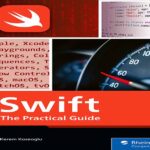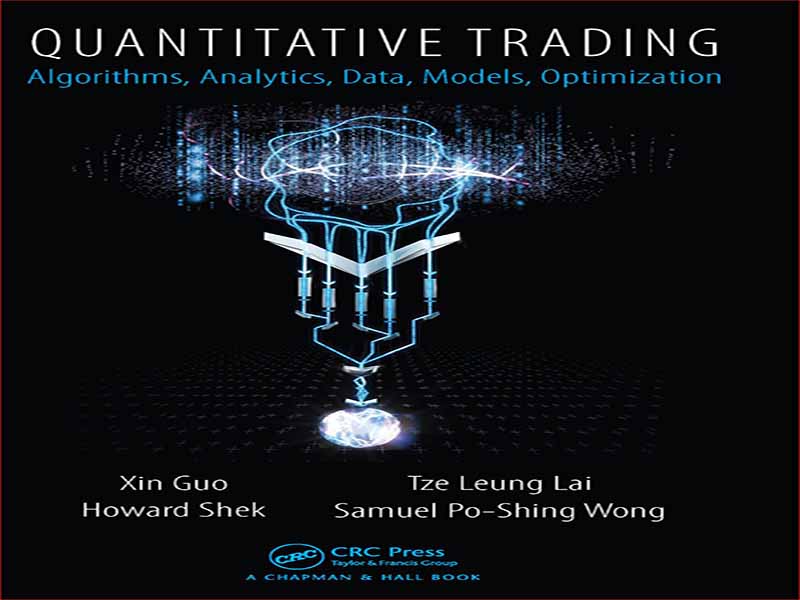- عنوان کتاب: Quantitative Trading Algorithms
- نویسنده: Xin Guo
- حوزه: تجارت
- سال انتشار: 2017
- تعداد صفحه: 381
- زبان اصلی: انگلیسی
- نوع فایل: pdf
- حجم فایل: 18.1 مگابایت
پس از دوره پرآشوبی که با بحران مالی 2007-2008 و رکود بزرگ سال 2009 مشخص شد، صنعت _مالی وارد دوره جدیدی شده است. استراتژیهای کمی همراه با مدلها و روشهای آماری، بازنمایی دانش و تجزیه و تحلیل دادهها و الگوریتمها و انفورماتیک برای توسعه و پیادهسازی آنها، در این عصر جدید از اهمیت روزافزونی برخوردار هستند. شروع این عصر با دو انقلاب مشخص شده است که زندگی و تجارت مدرن را متحول کرده است. یکی فناوری است که در شماره 9 مه 2015 اکونومیست برای خدمات مالی به نام “انقلاب فین تک” شناخته می شود که می گوید: سالها از سقوط 2007-2008، سیاستگذاران بر ایمنتر کردن Nance تمرکز کردهاند. . . . به دور از کانون توجه رگولاتور، انقلاب دیگری در راه است. . . . از پرداختها گرفته تا مدیریت ثروت، از وامدهی همتا به همتا گرفته تا تامین مالی جمعی، نسل جدیدی از استارتآپها قلب صنعت را هدف قرار میدهند{و مجموعهای از درآمد که گلدمن ساکس ارزش آن را 4.7 تریلیون دلار برآورد میکند. مانند دیگر مختل کننده های سیلیکون ولی، _ntech _rms به سرعت در حال رشد هستند.” دیگری “انقلاب داده های بزرگ” نامیده می شود. در آگوست 2014، دبیر کل سازمان ملل متحد یک گروه مشاور مستقل را مأمور کرد تا توصیه هایی را در مورد “انقلاب داده” در توسعه پایدار ارائه دهد. در 20 آگوست 2015، نخستوزیر جمهوری خلق چین از ادارات دولتی مختلف خواست تا دادههای خود را به اشتراک بگذارند و یک برنامه عملیاتی کلان داده را اجرا کنند. بلافاصله پس از آن، در 5 سپتامبر 2015، شورای دولتی این کشور یک برنامه اقدام برای توسعه و ترویج برنامه های کاربردی داده های بزرگ در برنامه ریزی اقتصادی، ملی، امنیت داخلی، حمل و نقل، کشاورزی، محیط زیست و مراقبت های بهداشتی صادر کرد. برای پاسخ به فرصتها و چالشهای این دوره جدید و دادههای بزرگ و انقلابهای فینتک که دانشآموزانشان را مجذوب کرده است، دو استاد دانشگاه (Guo و Lai) در تیم نویسنده، که اتفاقاً به دانشآموزان در دره سیلیکون بزرگتر آموزش میدهند، توسعه دادند. و در سه سال گذشته دوره های جدیدی را در برنامه درسی مهندسی مالی/ریاضی در برکلی و استنفورد تدریس کرد و مطالب درسی خود را مبادله کرد. آنها همچنین از تمرینکنندگان صنعت، بهویژه دو نویسنده مشترک دیگر (شِک و ونگ) دعوت کردند تا برای این دورهها سخنرانیها و سمینارهای مهمان ارائه کنند. این همکاری غیررسمی به سرعت به یک برنامه الکترونیکی هماهنگ و فشرده برای نوشتن مطالب در کتاب حاضر تبدیل شد که می تواند نه تنها برای آموزش مؤثرتر این دوره ها، بلکه برای ارائه دوره های کوتاه مدت و برنامه های آموزشی در جاهای دیگر مورد استفاده قرار گیرد، همانطور که در موسسه پیشرفته شانگهای انجام داده ایم. از امور مالی، دانشگاه فودان، دانشگاه تسینهوا، دانشگاه چینی هنگ کنگ، دانشگاه علم و فناوری هنگ کنگ، دانشگاه ملی سنگاپور، دانشگاه ملی تایوان، و دانشگاه ملی سئول. پیش نیاز یا شرط مشترک این دوره ها، دوره ای در سطح STATS 240 (روش های آماری در امور مالی) در استنفورد است که شش فصل اول Lai و Xing (2008) را پوشش می دهد. بنابراین ما به بخش های مربوطه این شش فصل ارجاع زیادی خواهیم داد و نتایج اصلی آنها را بدون تکرار جزئیات خلاصه می کنیم. وب سایت این کتاب را می توان در http://lait.web.stanford یافت. edu/quantstratbook/. مجموعه داده های تمرین ها و نمونه ها را می توان از وب سایت دانلود کرد. ما می خواهیم در کتاب یک رویکرد بین رشته ای برای توسعه و پیاده سازی تجارت الگوریتمی و استراتژی های کمی برجسته کنیم. رویکرد میان رشتهای که شامل علوم و مهندسی کامپیوتر، علوم و اقتصاد، ریاضیات و آمار، قانون و مقررات است، نه تنها در فعالیتهای تحقیقاتی موسسه مدلسازی مالی و ریسک (FARM) که اخیراً تأسیس شده در استنفورد، بلکه در دوره آموزشی مهندسی مالی برکلی و ریاضیات مالی استنفورد که در حال حاضر به برنامه گسترده تر ریاضی و مالی محاسباتی تبدیل شده است تا تاکید بیشتری بر علم داده، مدل سازی آماری، برنامه نویسی پیشرفته و محاسبات با عملکرد بالا داشته باشد. علاوه بر رویکرد میان رشتهای، یکی دیگر از ویژگیهای متمایز کتاب، پر کردن شکاف بین پژوهش/آموزش دانشگاهی و صنعت مالی است که یکی از مأموریتهای FARM نیز میباشد. بخشهای مختلف کتاب را میتوان در دورههای موضوعی کوتاه برای پزشکان مورد استفاده قرار داد، که در حال حاضر در FARM در حال توسعه هستند.
After the tumultuous period marked by the 2007-2008 Financial Crisis and the Great Recession of 2009, the _nancial industry has entered a new era. Quantitative strategies, together with statistical models and methods, knowledge representation and data analytics, and algorithms and informatics for their development and implementation, are of increasing importance in this new era. The onset of this era is marked by two \revolutions” that have transformed modern life and business. One is technological, dubbed \the FinTech revolution” for _nancial services by the May 9, 2015, issue of The Economist which says: \In the years since the crash of 2007-08, policymakers have concentrated on making _nance safer. . . . Away from the regulator spotlight, another revolution is under way. . . . From payments to wealth management, from peerto- peer lending to crowdfunding, a new generation of startups is taking aim at the heart of the industry { and a pot of revenues that Goldman Sachs estimates is worth $4.7 trillion. Like other disrupters from Silicon Valley, _ntech _rms are growing fast.” The other is called \big data revolution”. In August 2014, the UN Secretary General commissioned an Independent Advisory Group to make recommendations on \bringing about a data revolution” in sustainable development. The October 2012 issue of Harvard Business Review features an article on \Big Data: The Management Revolution”. On August 20, 2015, the Premier of the People’s Republic of China asked di_erent government departments to share their data and implement a big data action plan. Soon afterward, on September 5, 2015, the country’s State Council issued an action plan to develop and promote big data applications in economic planning, _nance, homeland security, transportation, agriculture, environment, and health care. To respond to the opportunities and challenges of this new era and the big data and FinTech revolutions that have fascinated their students, the two academics (Guo and Lai) on the author team, who happen to be teaching students in the greater Silicon Valley, developed and taught new courses in the Financial Engineering/Mathematics Curriculum at Berkeley and Stanford in the past three years and exchanged their course material. They also invited practitioners from industry, in particular the other two co-authors (Shek and Wong), to give guest lectures and seminars for these courses. This informal collaboration quickly blossomed into an intense concerted e_ort to write up the material into the present book that can be used not only to teach these courses more e_ectively but also to give short courses and training programs elsewhere, as we have done at Shanghai Advanced Institute of Finance, Fudan University Tsinghua University, Chinese University of Hong Kong, Hong Kong University of Science & Technology, National University of Singapore, National Taiwan University, and Seoul National University. A prerequisite or co-requisite of these courses is a course at the level of STATS 240 (Statistical Methods in Finance) at Stanford, which covers the _rst six chapters of Lai and Xing (2008). We will therefore make ample references to the relevant sections of these six chapters, summarizing their main results without repeating the details. The website for this book can be found at http://lait.web.stanford. edu/quantstratbook/. The datasets for the exercises and examples can be downloaded from the website. We want to highlight in the book an interdisciplinary approach to the development and implementation of algorithmic trading and quantitative strategies. The interdisciplinary approach, which involves computer science and engineering, _nance and economics, mathematics and statistics, law and regulation, is reected not only in the research activities of the recently established Financial and Risk Modeling Institute (FARM) at Stanford, but also in the course o_erings of Berkeley’s Financial Engineering and Stanford’s Financial Mathematics that has currently been transformed to the broader Mathematical and Computational Finance program to reect the greater emphasis on data science, statistical modeling, advanced programming and high performance computing. Besides the interdisciplinary approach, another distinctive feature of the book is the e_ort to bridge the gap between academic research/education and the _nancial industry, which is also one of the missions of FARM. Di_erent parts of the book can be used in short thematic courses for practitioners, which are currently being developed at FARM.
این کتاب را بصورت رایگان از لینک زیر دانلود نمایید.
Download: Quantitative Trading Algorithms




































نظرات کاربران